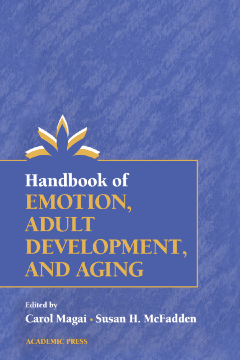
Additional Information
Book Details
Abstract
The field of emotions research has recently seen an unexpected period of growth and expansion, both in traditional psychological literature and in gerontology. The Handbook of Emotion, Adult Development, and Aging provides a broad overview and summary of where this field stands today, specifically with reference to life course issues and aging. Written by a distinguished group of contributing authors, the text is grounded in a life span developmental framework, while advancing a multidimensional view of emotion and its development and incorporating quantitative and qualitative research findings.
The book is divided into five parts. Part One discusses five major theoretical perspectives including biological, discrete emotions, ethological, humanistic, and psychosocial. Part Two on affect and cognition discusses the role of emotion in memory, problem solving, and internal perceptions of self and gender. Part Three on emotion and relationships expands on the role of emotion in sibling and parent/child relationships, as well as relationships between friends and romantic partners, and the emotional reaction to interpersonal loss across the life span. Part Four on stress, health, and psychological well-being treats issues of stress and coping, religion, personality, and quality of life. The final part on continuity and change in emotion patterns and personality discusses emotion and emotionality throughout the life span.
An ideal reference source for professionals across a wide range of disciplines, the text summarizes recent important developments in this fast growing area of psychology and proposes many new directions for future research.
- Provides a biopsychological view on emotion in adulthood from a life span context
- Presents the new perspective on emotion in older adults actively engaged in emotion self-regulation
- Describes the intimate connection between emotion and the structure of personality
- Demonstrates a new perspective on what emotion is, its importance across the life span, its connections with cognition, its role in interpersonal relation, and the way it influences both stability and change in adulthood
- Illustrates the interpersonal nature of emotion
- Provides theoretically based, leading edge research from international authors
- Five areas of coverage include:
- Theoretical perspectives
- Affect and cognition
- Emotion and relationships
- Stress, health, and psychological well-being
- Continuity and change in emotion patterns and personality
Coverage includes:
- Five major theoretical perspectives, including biological, discrete emotions, ethological, humanistic, and psychosocial
- The role of emotion in memory, problem-solving, and internal perceptions of self and gender
- The role of emotion in sibling and parent/child relationships, relationships between friends and romantic partners, and the emotional reaction to interpersonal loss across the lifespan
- Issues of stress and coping, religion, personality, and quality of life
- Emotion and emotionality throughout the lifespan
"The Handbook of Emotion, Adult Development, and Aging is the most comprehensive treatment to date of this nascent area of research... a substantial contribution and its many fine chapters will function as guideposts for this blossoming area of scholarly study as it continues to grow." --CONTEMPORARY GERONTOLOGY
"This is an exceptionally good collection of papers on emotion. It is an added bonus that they also deal with issues related to human development and aging... The handbooks focus on developmental themes is a special contribution. Although research on emotion has increased in recent years, relatively little has appeared on emotional processes in the middle and later parts of the life span. This book directly addresses these issues and does so in ways that clarify basic emotional processes at all levels. Although aimed at professionals and researchers in the field, many of the chapters will be accessible to upper-division undergraduates and graduate students with backgrounds in psychology, sociology, anthropology, or nursing." --CHOICE
